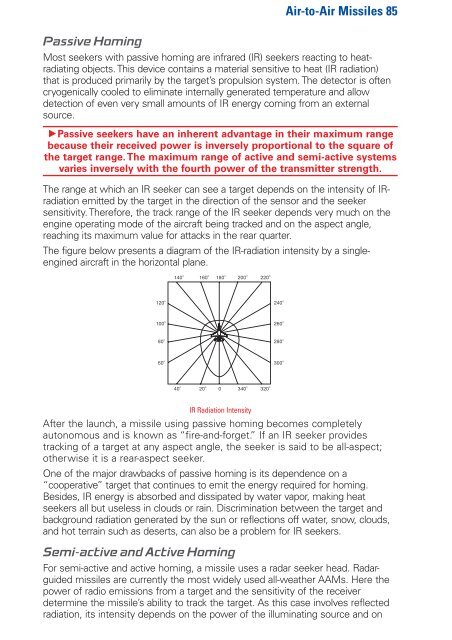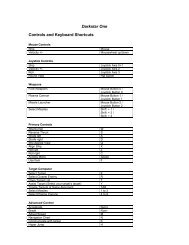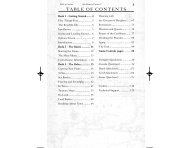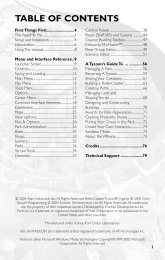Heads-Up Display Modes 35 - Metaboli
Heads-Up Display Modes 35 - Metaboli
Heads-Up Display Modes 35 - Metaboli
You also want an ePaper? Increase the reach of your titles
YUMPU automatically turns print PDFs into web optimized ePapers that Google loves.
Air-to-Air Missiles 85<br />
Passive Homing<br />
Most seekers with passive homing are infrared (IR) seekers reacting to heatradiating<br />
objects. This device contains a material sensitive to heat (IR radiation)<br />
that is produced primarily by the target’s propulsion system. The detector is often<br />
cryogenically cooled to eliminate internally generated temperature and allow<br />
detection of even very small amounts of IR energy coming from an external<br />
source.<br />
hPassive seekers have an inherent advantage in their maximum range<br />
because their received power is inversely proportional to the square of<br />
the target range. The maximum range of active and semi-active systems<br />
varies inversely with the fourth power of the transmitter strength.<br />
The range at which an IR seeker can see a target depends on the intensity of IRradiation<br />
emitted by the target in the direction of the sensor and the seeker<br />
sensitivity. Therefore, the track range of the IR seeker depends very much on the<br />
engine operating mode of the aircraft being tracked and on the aspect angle,<br />
reaching its maximum value for attacks in the rear quarter.<br />
The figure below presents a diagram of the IR-radiation intensity by a singleengined<br />
aircraft in the horizontal plane.<br />
IR Radiation Intensity<br />
After the launch, a missile using passive homing becomes completely<br />
autonomous and is known as “fire-and-forget.” If an IR seeker provides<br />
tracking of a target at any aspect angle, the seeker is said to be all-aspect;<br />
otherwise it is a rear-aspect seeker.<br />
One of the major drawbacks of passive homing is its dependence on a<br />
“cooperative” target that continues to emit the energy required for homing.<br />
Besides, IR energy is absorbed and dissipated by water vapor, making heat<br />
seekers all but useless in clouds or rain. Discrimination between the target and<br />
background radiation generated by the sun or reflections off water, snow, clouds,<br />
and hot terrain such as deserts, can also be a problem for IR seekers.<br />
Semi-active and Active Homing<br />
For semi-active and active homing, a missile uses a radar seeker head. Radarguided<br />
missiles are currently the most widely used all-weather AAMs. Here the<br />
power of radio emissions from a target and the sensitivity of the receiver<br />
determine the missile’s ability to track the target. As this case involves reflected<br />
radiation, its intensity depends on the power of the illuminating source and on















